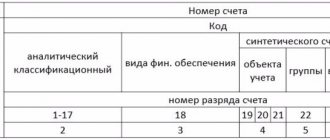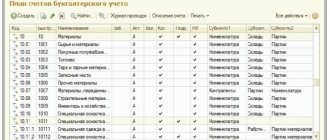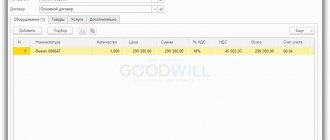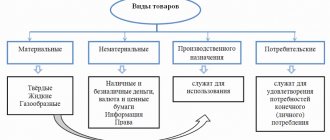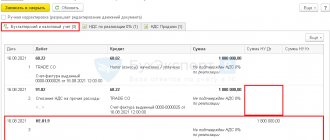Instruction 174n with changes for 2021 - changes in the chart of accounts (account 101)
Let's look at the main changes in account 101 00 000 “Fixed Assets”:
1. New wiring has appeared. When fixed assets are transferred for financial lease (gratuitous perpetual use) by the lessor (lender), the disposal of fixed assets classified as non-operating (financial) environment objects is reflected in the following entries:
| DEBIT account 0 401 10 172 “Income from transactions with assets” of the corresponding analytical accounting accounts: |
| 0 104 00 000 “Depreciation” |
| 0 114 00 000 “Impairment of non-financial assets” |
| CREDIT of the corresponding analytical accounting accounts account 0 101 00 000 “Fixed assets” |
2. A new group 00 “Fixed assets – property in concession” and analytical accounting accounts were introduced:
| Analytical accounting account | Account names |
| 0 101 91 000 | “Residential premises = property in concession” |
| 0 101 92 000 | “Non-residential premises (buildings and structures) – property in concession” |
| 0 101 94 000 | “Machinery and equipment – concession property” |
| 0 101 95 000 | “Vehicles – concession property” |
| 0 101 97 000 | “Biological resources – property in concession” |
| 0 101 98 000 | “Other fixed assets – property in concession” |
3. The group of accounting accounts 0 101 40 000 “Fixed assets – leased items” and analytical accounts for it (0 101 (41 – 48) 000) are excluded.
4. The following accounts have been excluded:
| Analytical accounting account | Account name |
| 0 101 18 000 | “Other fixed assets – real estate of the institution” |
| 0 101 21 000 | “Residential premises are particularly valuable movable property of an institution” |
| 0 101 23 000 | “Structures are especially valuable movable property of an institution” |
| 0 101 31 000 | “Residential premises – other movable property of the institution” |
| 0 101 43 000 | “Structures – leased items” |
5. Certain account names have been changed:
| Account name in the old version | Name of the account in the new edition |
| 0 101 26 000 “Industrial and business equipment - especially valuable movable property of the institution” | 0 101 26 000 “Industrial and economic equipment - especially valuable movable property of the institution” |
| 0 101 27 000 “The library collection is a particularly valuable movable property of the institution” | 0 101 27 000 “Biological resources are particularly valuable movable property of the institution” |
| 0 101 33 000 “Structures – other movable property of the institution” | 0 101 33 000 “Investment real estate” – other movable property of the institution |
| 0 101 36 000 “Industrial and business equipment - other movable property of the institution” | 0 101 36 000 “Industrial and economic inventory - other movable property of the institution” |
| 0 101 37 000 “Library collection – other movable property of the institution” | 0 101 37 000 “Biological resources – other movable property of the institution” |
Which depreciation method to choose
With the introduction of the federal standard, the list of methods for calculating depreciation expanded, while Instruction No. 157n offered only the linear method. The federal standard offered more options. In total, the accountant has three methods for calculating depreciation.
- Linear method. It involves the accrual of equal amounts of depreciation monthly over the entire useful life (USI). To calculate the payment, you need to divide the initial cost of the object by the investment cost.
- Reducing balance method. Convenient for those objects that quickly become obsolete or are operated in difficult conditions, in an aggressive environment. The method allows for accelerated depreciation by applying an increasing factor from 1 to 3 to the annual amount. The residual value of the object is taken as a basis (costs of purchase and commissioning minus accruals already paid off at the beginning of the reporting year), the depreciation rate is also taken into account based on the SPI and wear indicator.
- Method of calculating the amount of depreciation proportional to the volume of production. The method is good for objects for which the production potential inherent in them is indicated (that is, it is clear how many products the object can produce over its entire service life). The calculation is based on the actual volume of products produced for the reporting period, multiplied by the depreciation rate (initial cost / estimated volume of products over the useful life).
The institution has the right to determine the depreciation method independently, taking into account the specifics of the activities, but the main criterion should be the potential economic benefit. The chosen method must be indicated in the accounting policy.
Important! The purpose of operating an asset may change, which means the organization must check whether the chosen depreciation method is appropriate. This must be done at the beginning of the reporting year. If necessary, the method can be changed, but previous accruals do not need to be recalculated.
Another innovation: the federal standard obliges to charge depreciation even on those objects that are idle, temporarily not used, or prepared for further write-off. The exception is objects whose residual value is equal to zero. Instruction No. 157n allowed to suspend the accrual of depreciation amounts during such periods.
The federal standard also shifted the initial cost boundaries for low-value operating systems. Objects worth up to 10,000 rubles are accounted for on an off-balance sheet account; depreciation is not charged on them. Previously, there was a limit of 3,000 rubles. For objects costing from 10,000 to 100,000 rubles, depreciation is equal to 100% of the original cost at the time of commissioning. A special rule for the library fund is that the amount of depreciation for objects of the library fund worth up to 100,000 rubles is calculated and accrued at 100 percent at the time of commissioning. For objects over 100,000 rubles, depreciation amounts are determined according to the method chosen by the institution. This limit was previously set at 40,000 rubles.
Instruction 174n with changes for 2021 - changes in the chart of accounts (account 102)
On account 102 00 000, as in the old version of the Instructions, intangible assets are taken into account. But the changes affected this account too - analytical accounting accounts 0 102 40 000 “Intangible assets - leased items” were excluded.
That is, currently only 2 accounts are used to generate information about the presence of business transactions and intangible assets: (click to expand)
| Analytical accounting account | Account name |
| 0 102 20 000 | “Intangible assets are especially valuable movable property of an institution” |
| 0 102 30 000 | “Intangible assets - other movable property of an institution” |
Source documents
Primary budget accounting also deserves special attention. Registration of primary documents for any operations carried out by an organization is a standard requirement. As for the types of primary, there are some features.
Budgetary organizations use unified forms of classes 03 and 05 (more than 40 forms in total) from the All-Russian Classifier of Management Documents. Among them there are primary documents, the quality of which must be controlled especially carefully by accounting specialists. These are forms confirming cash transactions related to payroll accounting and accounting of material objects.
Instruction 174n with changes for 2021 - changes in the chart of accounts (account 103)
Non-productive assets are subject to accounting in account 103 00 000. After making adjustments to the Instructions, the following groups of accounts are now used to account for non-productive assets:
| Account group | Name |
| 0 103 10 000 | Non-productive assets – real estate of the institution |
| 0 103 30 000 | Non-productive assets – other movable property |
| 0 103 90 000 | Non-productive assets – as part of the grantor’s property |
Previously used analytical accounting accounts belong to the 1st group. New accounts have been introduced for groups 30 and 90:
| Check | Name |
| 0 103 32 000 | Subsoil resources – other movable property of the institution |
| 0 103 33 000 | Other non-produced assets – other movable property of the institution |
| 0 103 91 000 | Land is part of the grantor's property |
Instruction 174n with changes for 2021 - changes in the chart of accounts (account 104)
Account 104 00 000 “Depreciation” for accounting for depreciation charges has been adjusted to a significant extent:
1. Accounts excluded:
| Analytical accounting account | Name |
| 0 104 18 000 | Depreciation of other fixed assets – real estate of the institution |
| 0 104 21 000 | Depreciation of residential premises – especially valuable movable property of an institution |
| 0 104 23 000 | Depreciation of structures - especially valuable movable property of the institution |
| 0 104 31 000 | Depreciation of residential premises - other movable property of the institution |
| 0 104 43 000 | Depreciation of structures – leased items |
2. The name of the accounting group for account 0 104 40 000 has changed. Now the name is “Depreciation of rights to use assets”, previously it was “Depreciation of leased items”.
3. A new accounting group for account 0 104 40 000 “Depreciation of property in concession” was introduced.
4. New budget accounting entries have appeared:
| Operation | DEBIT | CREDIT |
| Termination of the right to use assets upon early termination of the agreement under which operating lease items were taken into account (disposal of an accounting item) must be reflected in the amount of accumulated depreciation of the right to use assets. | ... corresponding analytical accounting accounts account 0 104 40 000 “Depreciation of rights to use assets” | ... corresponding analytical accounting accounts account 0 111 40 000 “Rights to use non-financial assets” |
| Termination of the right to use an asset (subject to full execution of the contract) (disposal of an accounting object) must be reflected in the amount of the book value of the right to use the assets. | ... corresponding analytical accounting accounts account 0 104 40 000 “Depreciation of rights to use assets” | ... corresponding analytical accounting accounts account 0 111 40 000 “Rights to use non-financial assets” |
How to get started with the new standard
To properly implement FSBU, an institution must take several steps. And you should start with an inventory, which will give an idea of the state of fixed assets balances for correct accounting and application of the chosen depreciation method. It is necessary to check the property that was accounted for before January 1, 2021 on account 0 10100 000 for compliance with the standard. Having received data on objects that were previously reflected in off-balance sheet accounts or, according to some criteria, were not included in the fixed assets group, the accountant must put them on the balance sheet at their original cost.
Inventory results are standardly reflected in the Inventory List in the section on non-financial assets (form 0504087). It is important to mention that leasing objects, long-term lease with the right to buy, free (indefinite) use, and other rental payments are classified as NFA. For this purpose, by order of the Ministry of Finance of Russia dated November 17, 2017 No. 194n, additional columns were introduced into the inventory form: status of the accounting object, target function of the asset. New columns in the inventory have also appeared for objects that, after the introduction of the standard, do not meet the criteria of an asset. They are also entered into the Statement of Discrepancies based on the inventory results (form 0504092).
This needs to be done in order to divide the fixed assets into groups, including highlighting the objects of the “Investment Real Estate” group (currently they are taken into account according to separate analytics on account 101 and behind the balance on accounts 25 and 26).
In conclusion, I would like to note that the reform in public sector accounting and all the accompanying changes are associated with a change in the key task. If previously it was important to build control over settlements with the budget, now the assessment of the capitalization of organizations and the quality of the assets themselves comes to the fore.
Instruction 174n with changes for 2021 - changes in the chart of accounts (account 106)
Account 106 00 000 “Investments in non-financial assets” has also undergone some changes: (click to expand)
- Added account 0 106 33 000 “Investments in non-produced assets - other movable property of the institution.”
- The account group 0 106 90 000 “Investments in the property of the grantor” and analytical accounts for it were introduced: 0 106 91 000 “Investments in fixed assets in the concession” and 0 106 93 000 “Investments in non-produced assets in the concession”.
- Count group 40 has been renamed. Instead of the old name “Investments in leased objects” the name “Investments in financial lease objects” is now used.
For this reason, the following analytical accounting accounts were excluded:
| Check | Name |
| 0 106 41 000 | Investments in fixed assets – leased items |
| 0 106 42 000 | Investments in intangible assets – leased items |
| 0 106 44 000 | Investments in inventories – leased items |
* * *
Let us briefly formulate the main conclusions.
- The changes made by Order No. 212n to Instruction No. 174n came into force on 01/06/2018, and therefore they are subject to accounting in 2021.
- Among the significant amendments are the following innovations:
- Accounts 0 204 51 000 “Assets in management companies”, 0 215 51 000 “Investments in management companies” were removed from the accounting chart of accounts;
- a new procedure has been established for the formation of individual account numbers (0 201 00 000, 0 207 00 000, 0 209 81 000, 0 210 05 000, 0 301 00 000, 0 401 60 000);
- accounting records have been added to document the internal movement of non-financial assets between material persons, as well as in the case of their transfer for lease and trust management;
- adjustments have been introduced to account for VAT and subsidies allocated for the implementation of government tasks.
[1] Instructions for the use of the Chart of Accounts for accounting of budgetary institutions, approved. By Order of the Ministry of Finance of the Russian Federation dated December 16, 2010 No. 174n.
Budgetary organizations: accounting and taxation, No. 2, 2018
Instruction 174n as amended for 2021 - changes in the chart of accounts (account 0 111 00 000)
On the analytical accounting accounts of account 0 111 00 000 “Rights to use assets”, the following operating lease objects are recorded:
| Analytical accounting account | Name |
| 0 111 41 000 | Rights to use residential premises |
| 0 111 42 000 | Rights to use non-residential premises (buildings and structures) |
| 0 111 44 000 | Rights to use machinery and equipment |
| 0 111 45 000 | Rights to use vehicles |
| 0 111 46 000 | Rights to use industrial and household equipment |
| 0 111 47 000 | Rights to use biological resources |
| 0 111 48 000 | Rights to use other fixed assets |
| 0 111 49 000 | Rights to use non-produced assets |
Registration of transactions to reflect the rights to use assets:
| Operation | DEBIT | CREDIT |
| Recognition of an operating lease accounting object as a lessee (property user) | ... corresponding analytical accounting accounts account 0 111 40 000 “Rights to use non-financial assets” | Accounts 0 302 24 730 “Increase in accounts payable for settlements of rent for the use of property”; 0 302 29 730 “Increase in accounts payable for payments of rent for the use of land plots and other isolated natural objects” |
| Receipt of non-financial assets related to the objects of accounting for operating leases on preferential terms for free-term use in accordance with the agreement, reflected by the institution (user) of non-financial assets in the amount of the fair value of lease payments. | ... corresponding analytical accounting accounts account 0 111 40 000 “Rights to use non-financial assets” | … account 0 401 40 182 “Deferred income from gratuitous right of use” |
| Termination of the right to use an asset (if the contract is fully executed) (disposal of an accounting object) in the amount of the book value of the right to use the asset | ... corresponding analytical accounting accounts account 0 104 40 000 “Depreciation of rights to use assets” | ... corresponding analytical accounting accounts account 0 111 40 000 “Right to use non-financial assets” |
| Termination of the right to use an asset upon early termination of the agreement under which operating lease accounting items were taken into account (disposal of an accounting item) | The “red reversal” method in the amount of the residual value of the right to use the asset: DEBIT of the corresponding analytical accounts of account 0 111 40 000 “Rights to use non-financial assets” | CREDIT accounts 0 302 24 730 “Increase in accounts payable for settlements of rent for the use of property”, 0 302 29 730 “Increase in accounts payable for payments of rent for the use of land plots and other isolated natural objects”, 0 401 40 182 “Future income from gratuitous right of use.” |
| In the amount of accumulated depreciation of the right to use the asset: DEBIT of the corresponding analytical accounting accounts, account 0 104 40 000 “Depreciation of the right to use assets” | CREDIT to the corresponding analytical accounting accounts account 0 111 40 000 “Rights to use non-financial assets” |
Requirements for assessing objects
The federal standard did not ignore the assessment of fixed assets. He introduces new terms that distinguish between two types of possible operations on objects:
- Exchange transactions - assets are exchanged for money or other material assets; the cost of work performed, services provided or rights to use the asset can be taken into account towards the cost of the object. This exchange is based on the market value of the property. In exchange transactions, the object is valued based on the amount of actual costs.
- Non-exchange transactions - assets are transferred free of charge or for little money. In this case, the initial cost is determined based on the fair value of the object.
The founder must decide how to value different categories of objects, and the choice must be reflected in the accounting policies of the institution.
Instruction 174n as amended for 2021 - changes in the chart of accounts (account 0 114 00 000)
Let's consider which groups of accounts and analytical accounting accounts are used to generate, in monetary terms, information about accrued losses from impairment of fixed assets, intangible assets, non-produced assets and business transactions that reflect changes in impairment losses, in accordance with the objects of accounting and the content of the business transaction:
| Account group | Analytical accounts |
| 0 114 10 000 “Depreciation of the institution’s real estate” | 0 114 11 000 “Depreciation of residential premises - real estate of the institution” 0 114 12 000 “Depreciation of non-residential premises (buildings and structures) - real estate of institutions” 0 114 13 000 “Impairment of investment real estate - real estate of institutions” 0 114 15 000 “Depreciation of vehicles - real estate of institutions” |
| 0 114 20 000 “Depreciation of particularly valuable movable property of the institution” | 0 114 22 000 “Depreciation of non-residential premises (buildings and structures) - especially valuable movable property of institutions” 0 114 24 000 “Depreciation of machinery and equipment - especially valuable movable property of institutions” 0 114 25 000 “Depreciation of vehicles - especially valuable movable property of institutions” 0 114 26 000 “Depreciation of production and economic inventory - especially valuable movable property of institutions” 0 114 27 000 “Depreciation of biological resources - especially valuable movable property of institutions” 0 114 28 000 “Depreciation of other fixed assets – especially valuable movable property of institutions” 0 114 29 000 “Depreciation of intangible assets - especially valuable property of institutions” |
| 0 114 30 000 “Depreciation of other movable property of the institution” | 0 114 32 000 “Depreciation of non-residential premises (buildings and structures) - other movable property of institutions” 0 114 33 000 “Impairment of investment real estate – other movable property of institutions” 0 114 34 000 “Depreciation of machinery and equipment – other movable property of institutions” 0 114 35 000 “Depreciation of vehicles – other movable property of institutions” 0 114 36 000 “Depreciation of production and economic inventory - other movable property of institutions” 0 114 37 000 “Depreciation of biological resources - other movable property of institutions” 0 114 38 000 “Depreciation of other fixed assets – other movable property of institutions” 0 114 39 000 “Depreciation of intangible assets – other movable property of institutions” |
| 0 114 60 000 “Impairment of non-productive assets” | 0 114 61 000 “Depreciation of land - non-productive assets” 0 114 62 000 “Impairment of subsoil resources – non-productive assets” 0 114 63 000 “Impairment of other non-productive assets - non-productive assets” |
For the listed accounts, transactions will be reflected in the following entries:
| Operation | DEBIT | CREDIT |
| Accrual of losses from impairment of fixed assets, intangible assets and non-productive assets | 0 401 20 274 “Losses from impairment of assets” | Analytical accounting accounts account 0 114 00 000 “Impairment of non-financial assets” |
| Taking into account amounts of losses from impairment of non-financial assets upon receipt of fixed assets, intangible assets, and non-productive assets | When transferring between the head office and separate divisions (branches): DEBIT of analytical accounting accounts account 0 304 04 000 “Internal departmental settlements” | CREDIT of analytical accounting accounts account 0 114 00 000 “Impairment of non-financial assets” |
| If received free of charge: DEBIT account 0 401 10 189 “Other income” | CREDIT to analytical accounting accounts 0 114 00 000 “Impairment of non-financial assets” | |
| When internally moving accounting objects when they are classified (excluded) into (from) the category of especially valuable movable property: DEBIT account 0 401 10 172 “Income from transactions with assets” | CREDIT of analytical accounting accounts of account 0 114 00 000 “Impairment of non-financial assets” (with simultaneous reflection in DEBIT of the corresponding analytical accounting accounts of account 0 114 00 000 “Impairment of non-financial assets” and CREDIT of account 0 401 10 172 “Income from transactions with assets”). | |
| Write-off of accumulated losses from impairment of non-financial assets for caused fixed assets, intangible assets, non-productive assets | When transferring fixed assets, intangible assets, non-productive assets within the framework of settlements between the head office, separate divisions (branches), reflected on the basis of primary documents drawn up by the transferring and receiving parties, and notification in form 0504805: DEBIT of analytical accounting accounts 0 114 00 000 “Impairment non-financial assets" | CREDIT of analytical accounting accounts 0 304 04 000 “Internal departmental settlements” |
| When transferring accounting objects to a government body, state (municipal) institution, reflected on the basis of primary documents drawn up by the transferring and receiving parties, and notification in form 0504805: DEBIT of analytical accounting accounts account 0 114 00 000 “Impairment of non-financial assets” | CREDIT account 0 401 20 241 “Expenses for gratuitous transfers to state and municipal organizations” | |
| When transferring fixed assets upon their sale on the basis of a decision of the permanent commission on receipt and disposal of assets, on the gratuitous transfer of fixed assets, intangible assets, adopted in accordance with the laws of the Russian Federation (in relation to organizations other than international financial organizations, supranational organizations and foreign governments , individuals), incl. when a budgetary institution creates other organizations, as well as the disposal of fixed assets, intangible assets in accordance with the decision made to write them off, when transferring fixed assets into non-operating (financial lease): DEBIT of analytical accounting accounts account 0 114 00 000 “Impairment of non-financial assets” | CREDIT of analytical accounting accounts account 0 101 00 000 “Fixed assets”, accounts 0 102 00 000 “Intangible assets” |
New criteria for fixed assets
The Federal Standard does not replace Instruction No. 157n (as amended on September 27, 2017), but establishes fundamental accounting rules for fixed assets (fixed assets).
The two documents exist in parallel, and in the near future we can expect that this instruction and the acts detailing it (No. 162n, 174n, 182n) will be adjusted in accordance with the provisions of the Federal Accounting Service. One of the most important differences lies in the very interpretation of the term “fixed assets”. From January 1, 2021, this concept includes not just material objects, but material values that are assets. This means that in addition to the standard requirements for an object, a new one appears - to have useful potential. This means that the object can be used to perform state (municipal) functions or provide services, pay off obligations, or exchange for other assets. An object can be accepted for accounting as a fixed asset only if its initial cost is reliably estimated.
If these criteria of the federal standard are not met, then the object is accounted for in an off-balance sheet account. Please note: in contrast to instruction No. 157n, there are no conditions for mandatory state registration of rights to real estate in the FSB.
Another innovation is the ability to classify leased objects or those received for use free of charge as fixed assets. The requirements for such OS are dictated by the FSBU "Rent". In addition, some treasury property should now be taken into account as fixed assets. At the same time, two groups of objects are removed from the category of fixed assets: biological assets, if they are used for the production of bioproducts, and real estate intended for sale. Perennial plantings themselves (not producing bioproducts) remain part of the OS. A separate accounting account may be allocated for them.
A cultural heritage asset is recognized by the OS only in two cases: if there is an opportunity to obtain future economic benefits or useful potential associated with the specified asset, or if its useful potential is not limited to cultural value. In other cases, such an object is reflected in off-balance sheet accounts at a conditional valuation of 1 ruble.
There are few significant differences in the definition of the accounting unit and the procedure for accepting fixed assets for accounting. It is worth mentioning that the FSB introduces the concept of “OS complex”, that is, it allows objects with an equal useful life and insignificant cost to be considered as an inventory unit.
Instruction 174n with changes for 2021 - changes in the chart of accounts (account 205 00)
Account 205 00 000 “Calculations for income” reflects calculations for the income of a budgetary institution and transactions with them. Let's look at the changes:
1. New budget accounting entries have appeared:
| Operation | DEBIT | CREDIT |
| Accrual of income from rental property of a budget institution transferred under operating lease to tenants on the basis of agreements with them | 2,205 21,560 “Increase in accounts receivable for operating lease income” | 2 401 40 121 “Deferred income from operating leases” |
| Accrual of income from the rental of property of a budgetary institution transferred under a non-operating (financial) lease to tenants under an agreement | 2,205 22,560 “Increase in accounts receivable for income from finance leases” | 2 401 40 122 “Deferred income from finance leases” |
| Income from reimbursement to the lessor of expenses for the maintenance of the property transferred by him for use (upon the fact of corresponding requirements to the lessee) | 0 205 35 560 “Increase in accounts receivable for income from contingent rental payments” | 0 401 10 135 “Income from conditional rental payments” |
| Debt for unused balances of subsidies for other purposes in terms of balances, the need for which is not confirmed by the founder | 5,205 83,560 “Increase in accounts receivable for settlements of subsidies for other purposes” | 5 303 05 730 “Increase in accounts payable for other payments to the budget” |
| Debt for unused balances of subsidies for the purpose of budget investments in terms of balances, the need for which is not confirmed by the founder | 6,205 84,560 “Increase in accounts receivable for settlements of subsidies for capital investments” | 6 303 05 730 “Increase in accounts payable for other payments to the budget” |
2. New accounts have been introduced:
| Check | Name |
| 0 205 22 000 | Calculations of income from finance leases |
| 0 205 23 000 | Calculations of income from payments for the use of natural resources |
| 0 205 24 000 | Calculations of income from interest on deposits, cash balances |
| 0 205 25 000 | Calculations of interest income on loans provided |
| 0 205 26 000 | Calculations of interest income on other financial instruments |
| 0 205 27 000 | Calculations of income from dividends from investment objects |
| 0 205 28 000 | Calculations of income from the granting of non-exclusive rights to the results of intellectual activity and means of individualization |
| 0 205 29 000 | Calculations for other income from property |
| 0 205 32 000 | Calculations of income from the provision of services (work) under the compulsory health insurance program |
| 0 205 33 000 | Calculations of income from fees for providing information from government sources (register) |
| 0 205 35 000 | Calculations for contingent lease payments |
| 0 205 83 000 | Calculations for subsidies for other purposes |
| 0 205 84 000 | Calculations for subsidies for capital investments |
| 0 205 89 000 | Calculations for other income |
3. Account names have been changed:
| Check | Name in the old edition | Name in the new edition |
| 205 21 | Calculations of income from operating leases | Settlements with payers of property income |
| 205 31 | Calculations of income from the provision of paid services (works) | Settlements with payers of income from the provision of paid work and services |
| 205 81 | Settlements with payers of other income | Settlements with payers of other income |
4. Account group 40 “Calculations for forced seizure amounts” has been excluded.
Instruction 174n as amended for 2021 - changes in the chart of accounts (account 206 00)
In KOSGU, new sub-items were added to account 206 00 000 “Settlements for issued advances”, and therefore new accounts are being introduced:
| Check | Sub-article KOSGU |
| 0 206 96 000 “Calculations for advances for payment of other expenses” | 296 (from January 1, 2021) |
| 0 206 27 000 “Calculations for insurance advances” | 227 (from January 1, 2021) |
| 0 206 28 000 “Calculations for advances for services, work for the purpose of capital investments” | 228 (from January 1, 2021) |
| 0 206 29 000 “Calculations for advance payments for rent for the use of land plots and other isolated natural objects” | 229 (from January 1, 2021) |
Instruction 174n with changes for 2021 - changes in the chart of accounts (account 208)
Important!
From January 1, 2021, subarticle 291 “Taxes, duties and fees” of KOSGU must reflect the costs of paying taxes (which can be included in expenses), government duties and fees, and various payments to budgets of all levels. Account 208 91 000 is now called “Settlements with accountable persons for payment of duties and fees”.
New analytical accounting accounts have also been introduced into account 208 00 000:
| Check | Sub-article KOSGU |
| From January 1, 2021 | |
| 0 208 93 000 “Settlements with accountable persons for payment of fines for violation of the terms of contracts (agreements)” | 293 |
| 0 208 95 000 “Settlements with accountable persons for payment of other economic sanctions” | 295 |
| 0 208 96 000 “Settlements with accountable persons for payment of other expenses” | 296 |
| From January 1, 2021 | |
| 0 208 27 000 “Settlements with accountable persons for payment of insurance” | 227 |
| 0 208 28 000 “Settlements with accountable persons for payment for services and work for capital investment purposes” | 228 |
| 0 208 29 000 “Settlements with accountable persons for payment of rent for the use of land plots and other isolated natural objects” | 229 |
Instruction 174n with changes for 2021 - changes in the chart of accounts (account 209)
An accountant, when making calculations on the amounts of damage caused to a budgetary institution and other income on account 209 00 000, will have to take into account the innovations:
1. Settlements for other income are reflected in account 209 89 000 (not in account 209 83 000).
2. The name of the group of accounts 209 40 has changed - now it is “Calculations for fines, penalties, penalties, damages” (not “Calculations for forced seizure amounts”).
3. New accounts have been introduced:
| Check | Name |
| 0 209 34 000 | Cost compensation calculations |
| 0 209 41 000 | Calculations of income from penalties for violation of the terms of contracts (agreements) |
| 0 209 43 000 | Calculations of income from insurance claims |
| 0 209 44 000 | Calculations of income from compensation for property damage (except for insurance premiums) |
| 0 209 45 000 | Calculations of income from other amounts of forced seizure |
Answers to common questions about what is instruction 174n with changes for 2021
Question #1:
At what time should the lessee (user of the property) recognize the object of accounting for an operating lease by debiting account 0 111 40 000 and crediting accounts 0 302 24 730 or 0 302 29 730?
Answer:
It is necessary to recognize the accounting object of an operating lease on the date of classification of the lease accounting object in the amount of lease payments for the entire period of use of the property provided for in the lease agreement.
Question #2:
What is the reason for the introduction of new analytical accounting accounts in accounts 208 00 000 and 206 00 000, according to Instruction 174n?
Answer:
These innovations are associated with the presence of new subarticles of KOSGU.
